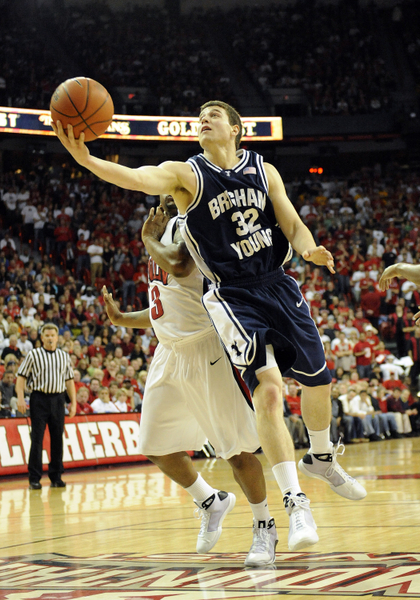RTC Conference Primers: #8 – Mountain West Conference
Posted by Brian Goodman on October 29th, 2010Andrew Murawa is the RTC correspondent for the Pac-10 and Mountain West Conferences and an occasional contributor
Predicted Order of Finish
- San Diego State (13-3)
- BYU (12-4)
- New Mexico (11-5)
- UNLV (11-5)
- Colorado State (9-7)
- Wyoming (6-10)
- Utah (6-10)
- TCU (3-13)
- Air Force (1-15)
All-Conference Team (key stats from last season in parentheses)
- G: Jimmer Fredette, Sr, BYU (22.1 PPG, 4.7 APG)
- G: Dairese Gary, Sr, New Mexico (13.1 PPG, 3.9 APG)
- G: Tre’Von Willis, Sr, UNLV (17.2 PPG, 3.9 RPG)
- F: Afam Muojeke, Jr, Wyoming (16.8 PPG, 3.9 RPG)
- F: Kawhi Leonard, Soph, San Diego State (12.7 PPG, 9.9 RPG)
6th Man
Billy White, Sr, San Diego State (11.1 PPG, 4.3 RPG)
Impact Newcomer
Drew Gordon, Jr, New Mexico – Gordon left UCLA midway through the Bruins awful season last year after never meshing with Ben Howland and his system, and as a result, he won’t be eligible for Steve Alford until after the first semester. But Gordon showed enough talent in his years in Westwood that he will be a welcome addition for what was an undersized Lobo team last season. However, Gordon did tear the meniscus in his right knee in mid-October and, although he is not expected to miss any game action, he may miss out on valuable practice time leading up to his expected December 17 debut.
What You Need to Know
- Best In The West? Given the Mountain West’s history as a contender for the title of the top non-BCS conference in the nation, and given that the Pac-10 is at its lowest point in memory, it’s quite possible that, at least for 2010-11, the MWC may be the best conference in the West. Last season, four MWC teams advanced to the NCAA Tournament, and in just over a decade of existence, only once has the MWC failed to place more than one team to the Big Dance (2000-01). However, major changes are afoot in the conference, as Utah and BYU, both consistently strong basketball forces, will be leaving for the Pac-10 and WCC, respectively. Boise State, Fresno State and Nevada will join the conference, but while those teams are capable of putting together strong seasons (Nevada, in particular, has recent success on the court), they’ll be hard-pressed to replace the production of the two Utah schools.
- Familiar Faces: When you look around the conference this season, there will be a lot of veterans up and down the rosters, as 70% of the players that averaged more than five points per game last season return. Only Utah, of the nine conference teams, will look drastically different, as they lost two starters to graduation, a third starter to transfer, and five additional bench players to transfers as well. Bolstering the general experience around the league is a flood of incoming transfers: Drew Gordon and Emmanuel Negedu at New Mexico, Quintrell Thomas at UNLV, Hank Thorns at TCU, Wes Eikemeier at Colorado State and James Rahon at San Diego State. Not only will there be a lot of recognizable players on the court, there continues to be a lot of stability on the sidelines, as for the second consecutive year, every head coach in the MWC returns.
- Non-conference Boost: Last season seemed to mark the first year of a new era in non-conference scheduling in the MWC. After earning a reputation as a conference whose teams would play consistently tough games, they slipped out of the top 20 in non-conference strength of schedule for a stretch from the 2006-07 season through the 2008-09 season. However, last year, the MWC addressed this in several ways. First and foremost, their teams were able to go out and get games against Pac-10 and Big 12 competition, but they were also able to get their teams in some good early-season tournaments, and they began the MWC/MVC Challenge, guaranteeing every team in the conference a matchup with a team from the Missouri Valley. That MWC/MVC Challenge will continue (the two conferences signed a four-year agreement), as will the involvement of conference teams in early-season tournaments (for instance, New Mexico plays in the Las Vegas Classic, UNLV in the 76 Classic, Colorado State in the Cancun Governor’s Cup, BYU in the South Padre Island Classic, Utah in the Diamondhead Classic, Wyoming in the Cancun Classic and San Diego State in the CBE Classic – and yes, the people that run these tournaments need to consult a thesaurus for an alternative to “Classic”). Additionally, the tougher non-conference scheduling continues, with conference schools making trips to places like Spokane, Berkeley, Logan, Ann Arbor, El Paso, Dayton, Tulsa, Louisville and Kansas City over the course of the non-conference slate.












































